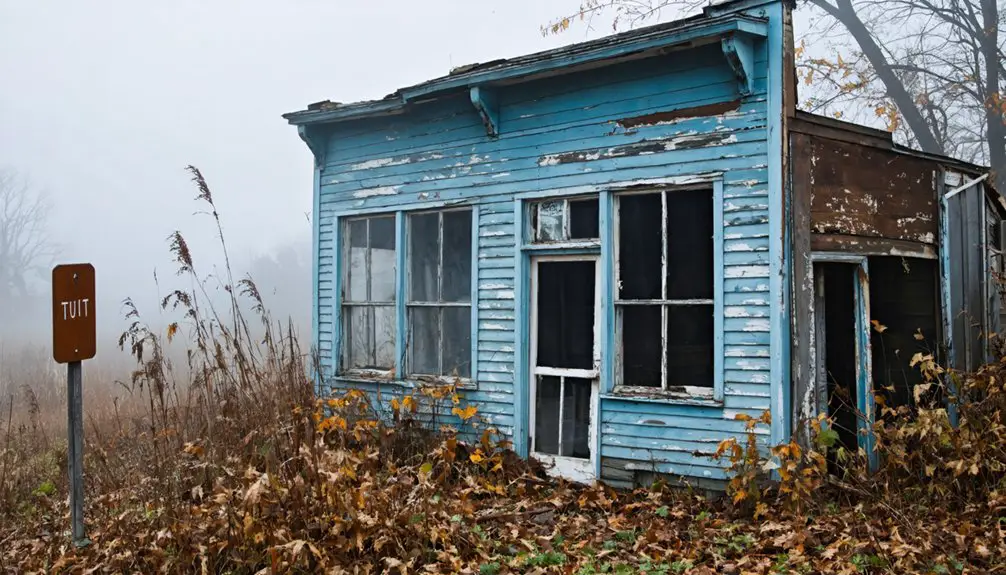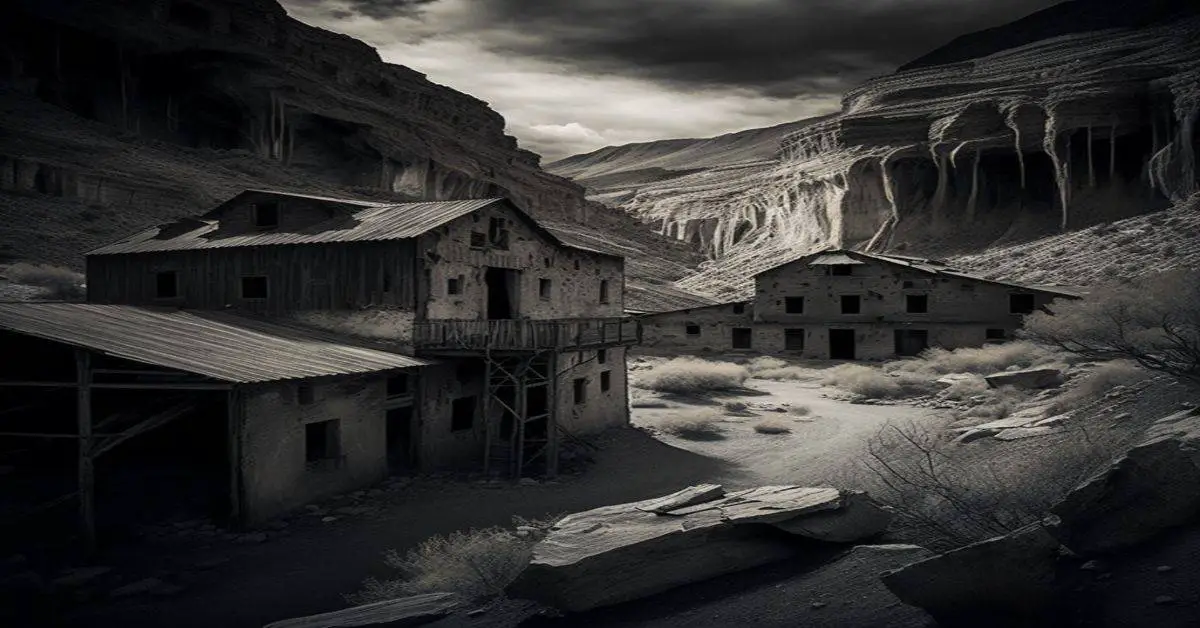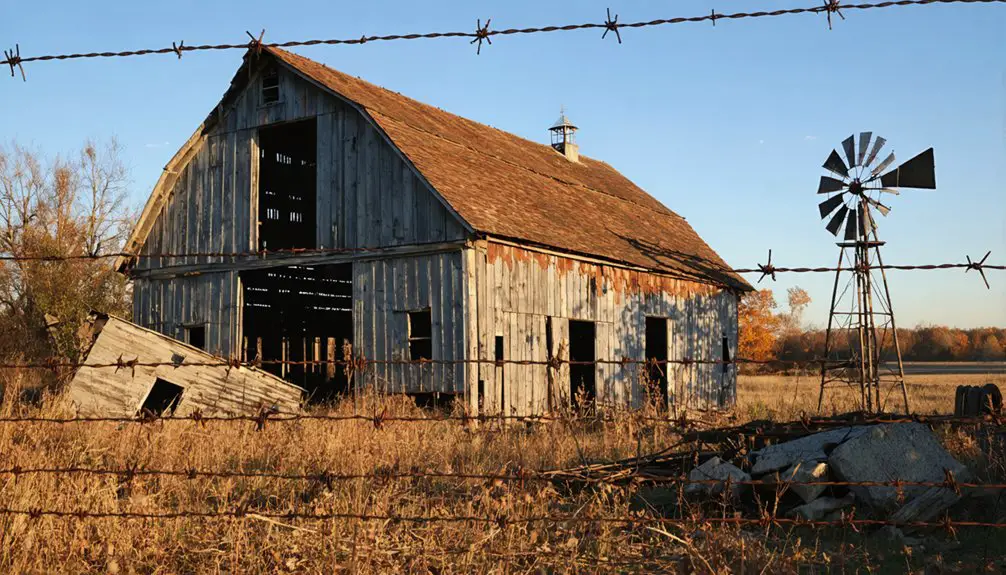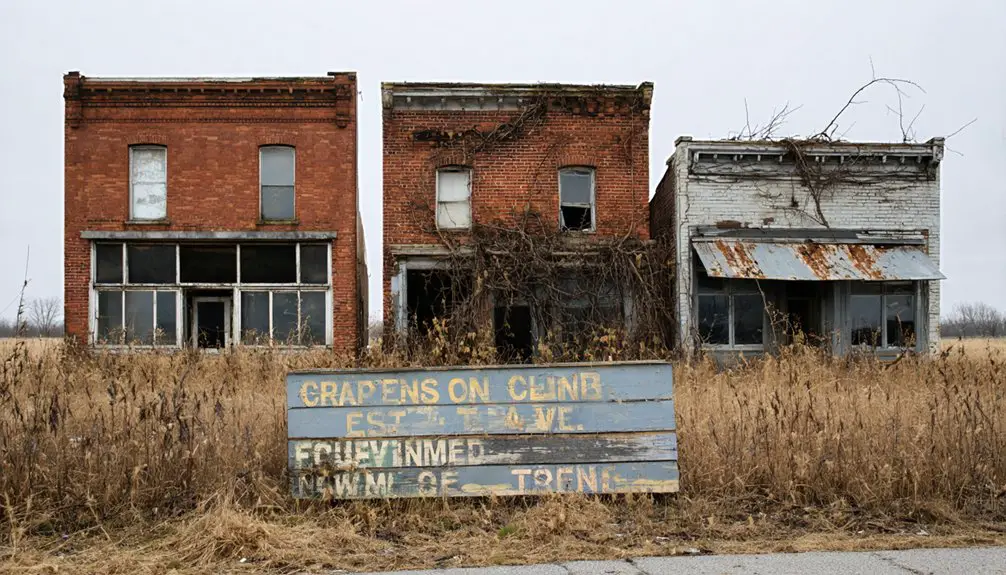You’ll find Blue Ball, Ohio‘s ghostly remains in what’s now Middletown, where a distinctive blue-painted tavern ball once guided travelers along the Great Miami Turnpike. Founded in 1796 by William Humphreys, the town flourished around its namesake tavern until 1993, when Middletown annexed it. Though its population dwindled to 752, historic landmarks like Dicks Creek Church still stand. The town’s unique story, from frontier settlement to semi-ghost status, reveals fascinating chapters of Ohio’s pioneer past.
Key Takeaways
- Blue Ball, Ohio became a ghost town after its 1993 annexation into Middletown, reducing its population to 752 residents.
- The town’s name originated from a blue-painted ball on a tavern sign erected by Jonathan Emmons in 1823.
- First settled in 1796, Blue Ball featured historic structures including the Blue Ball Tavern, Dicks Creek Church, and early schoolhouses.
- The loss of independent status led to closure of key institutions and diminishing community identity.
- The Blue Ball Historical Society works to preserve the town’s legacy through documentation and maintaining historical sites.
The Birth of a Peculiar Name
While many Ohio towns derive their names from prominent settlers or geographic features, Blue Ball‘s peculiar name stems from a simple tavern sign erected by Jonathan Emmons in 1823.
An Ohio tavern keeper’s roadside marketing gimmick in 1823 gave the town of Blue Ball its quirky name.
You’ll find the tavern significance reflected in Emmons’ clever marketing strategy – he mounted a distinctive blue-painted ball at the crossroads to catch travelers’ attention, especially those who couldn’t read.
The name evolution of this settlement is particularly interesting. Originally called Guilford after a local politician, the community gradually adopted the more practical “Blue Ball” designation. The fifth installment of the Blue Ball symbol has become a cherished landmark for locals.
The landmark proved so useful for navigation and so memorable for locals that town leaders officially changed the name in 1862.
It’s a perfect example of how everyday landmarks could shape a community’s identity on the American frontier. The tavern’s strategic location along the Great Miami Turnpike made it a popular stopping point for travelers between Cincinnati and Dayton.
Early Settlement and Pioneer Days
When William Humphreys purchased his plot in 1796, he initiated Blue Ball’s first permanent settlement near a natural spring. You’d have found a settler named Bowersock living in a rough chopper’s cabin before Humphreys built his log house in 1797.
The pioneer lifestyle attracted Revolutionary War veterans and their descendants, who came from northeastern states like New Jersey and Pennsylvania. Most pioneers transported their belongings using covered wagons while crossing the challenging Appalachian terrain. Due to multiple meanings of place names, settlers had to rely on clear navigation between similar-sounding settlements.
These early settlers faced typical settlement challenges, building hewn log structures and establishing essential community foundations. By 1800, they’d built the Blue Ball School, and Dicks Creek Church followed in 1810.
Joseph Parks constructed the area’s first brick home, marking a shift from temporary shelters to permanent dwellings. The community’s strategic location along key travel routes between Cincinnati and Dayton helped guarantee its early success.
Life Around the Blue Ball Tavern
As these pioneering families built their homes and community foundations, the Blue Ball Tavern emerged as the heartbeat of local life in the late 18th century.
The tavern culture centered around both travelers and locals, creating a vibrant hub of social activity at the crossroads of major transportation routes. Modern historians have preserved these historical records through digital collection systems that help maintain this important cultural heritage.
You’d find these essential elements of communal gatherings at the tavern:
- Stagecoach coordination through the distinctive blue ball signal system
- Exchange of news and political discourse among settlers
- Essential services including meals, lodging, and horse care
- Meeting space for local organizations and churches
The tavern’s influence was so significant that by 1852, the surrounding settlement officially adopted the name Blue Ball, cementing its role as the cornerstone of regional identity and commerce.
Historical Landmarks and Heritage
When you visit Blue Ball today, you’ll find Jonathan Emmons’ tavern site marked by the iconic blue ball that has guided travelers since 1823.
The town’s religious heritage lives on through landmarks like the 1810 Dicks Creek Church and Blue Ball Presbyterian Church, which continue serving the community even after the 1993 Middletown annexation.
While the original 1800 schoolhouse no longer stands, these preserved structures tell the story of a once-thriving crossroads community that shaped Butler County’s early development. The town was originally called Guliford before its name change in 1862. The 1904 Map of Mason is the earliest known map documenting the town’s layout and historic structures.
Blue Ball Tavern Legacy
The historic Blue Ball Tavern, established by Jonathan Emmons in the early 1800s, left an indelible mark on Ohio’s frontier landscape.
You’ll find its legacy in the distinctive blue-painted ball that marked the crossroads, altering tavern architecture from a humble log cabin to a sturdy brick establishment in 1821.
The tavern’s impact continues through these enduring elements:
- The tavern’s name shaped the entire community’s identity, leading to the official adoption of “Blue Ball” in 1852.
- As a significant hub for community gatherings, it served as an informal post office and social center.
- The building exemplified the change from frontier construction to permanent settlement architecture.
- Its strategic location at Cincinnati-Dayton Road made it an essential waypoint for travelers and locals alike.
Though the community was eventually annexed by Middletown in 1994, digital preservation efforts have made it possible to explore the tavern’s historical significance through digital collections that showcase its architectural evolution and cultural importance.
Religious Buildings Endure
Beyond the bustling tavern life, Blue Ball’s religious structures stand as enduring monuments to the town’s spiritual heritage.
You’ll find the Presbyterian Church at 6901 Roosevelt Road, where it continues to serve as a symbol of community resilience even after Middletown’s 1993 annexation of Blue Ball.
These 19th-century religious buildings, strategically built near natural springs, reflect the settlers’ commitment to establishing lasting spiritual foundations.
The church maintains its historical records through digital collection management, ensuring preservation of its rich heritage for future generations.
While the town has faded into semi-ghost status, the Presbyterian Church remains active, hosting historical talks and preserving artifacts that tell the story of pioneer life.
Its classic architectural elements and documented history in rare photographs provide you with a tangible link to Blue Ball’s origins, keeping the town’s identity alive despite its declining population.
Preserved Educational Landmarks
Standing as a representation of early frontier education, Blue Ball’s original schoolhouse from 1800 anchors the village’s rich educational heritage.
You’ll find this pioneering institution‘s educational significance reflected in the community’s dedication to preserving its historical landmarks.
Throughout Blue Ball’s evolution, you’ll discover these essential educational touchstones:
- The log-built schoolhouse that served as one of the region’s earliest formal learning centers
- The iconic Blue Ball Tavern, which doubled as an educational waypoint for travelers
- Historic log houses like William Humphreys’ 1797 home that hosted informal learning gatherings
- Dicks Creek Church, established in 1810, which merged religious teaching with community cohesion
These preserved landmarks tell the story of frontier education and continue to stand as proof of Blue Ball’s commitment to learning and community development.
From Thriving Town to Semi-Ghost Status
You’ll find Blue Ball’s transformation from a bustling crossroads community to a semi-ghost town marked by its 1993 annexation into Middletown, which stripped away its independent identity and postal designation.
The town’s population shrank to just 752 residents as key institutions like the local school closed, signaling the end of its autonomy as a self-sufficient community.
While the iconic metal blue ball still hangs at the intersection of Dixie Highway and Roosevelt Avenue, it now serves more as a historical curiosity than the vibrant landmark it once was for this former stagecoach stop.
Population Decline Over Time
Although Blue Ball began as a promising settlement in 1796, its population trajectory would follow a familiar pattern seen across many small Ohio towns. The demographic shifts mirrored broader regional population trends, particularly during the post-1960s era when numerous Rust Belt communities experienced dramatic declines.
You’ll find Blue Ball’s population decline was driven by:
- Industrial displacement and factory closures leading to significant job losses
- Outmigration to suburban areas around Cincinnati and Dayton
- Reduced birth rates following the Baby Boom era
- Aging demographics with fewer young families moving in
Today, what you’ll see in Blue Ball reflects its transformation from a vibrant crossroads community to a semi-rural area. The town’s historic landmarks, like the Blue Ball Tavern, stand as reminders of its more populous past.
Lost Identity Through Annexation
When Middletown officially annexed Blue Ball in 1993-1994, the historic settlement lost more than just its independent status – it lost its distinct identity as a community.
You’ll find that this once-proud town, with roots dating back to 1796, saw its autonomy dissolve as it became absorbed into Middletown’s expanding urban landscape.
While the Blue Ball Tavern and iconic blue ball signage remain as cultural touchstones, the community pride that once defined this independent town has largely faded into Middletown’s administrative framework.
Identity preservation efforts by the Blue Ball Historical Society attempt to keep the town’s legacy alive, but the reality is stark – local governance, postal recognition, and even basic infrastructure now operate under Middletown’s jurisdiction, leaving Blue Ball’s historic character increasingly relegated to memory.
Preserving Historical Town Features
Despite Blue Ball’s shift from thriving town to semi-ghost status, several key historical features still stand as evidence of its rich heritage.
You’ll find the town’s historical significance preserved through active community involvement, particularly in maintaining these enduring landmarks:
- The iconic Blue Ball tavern symbol, now in its fifth iteration since 1823, stands proudly at Roosevelt Road and Dixie Highway.
- The Dicks Creek Church and Blue Ball Presbyterian Church, dating back to 1810, continue serving as cultural anchors.
- Historic structures including original log cabins and the legendary “Bloody Bridge” offer glimpses into pioneer life.
- The town’s first school site from 1800 remains a reflection of early educational foundations.
Though many original buildings have vanished, these preserved features keep Blue Ball’s story alive through dedicated local preservation efforts.
Local Legends and Cultural Impact
Since its founding in the early 19th century, Blue Ball’s cultural identity has centered around its iconic blue metal ball tavern sign that once guided weary travelers at an essential crossroads.
You’ll find that local folklore emphasizes how this simple symbol helped illiterate travelers navigate while fostering a sense of community that’s endured for generations.
While the town hasn’t generated extensive supernatural tales like other Ohio ghost towns, community traditions remain strong through landmarks like the Blue Ball Presbyterian Church.
Even after Middletown’s 1993 annexation, the town’s 752 residents have maintained their distinct identity.
The blue ball symbol continues to attract visitors nationwide, making this semi-ghost town a reflection of how historical symbols can preserve a community’s spirit despite modern urbanization’s relentless march.
The Blue Ball Symbol Through Time
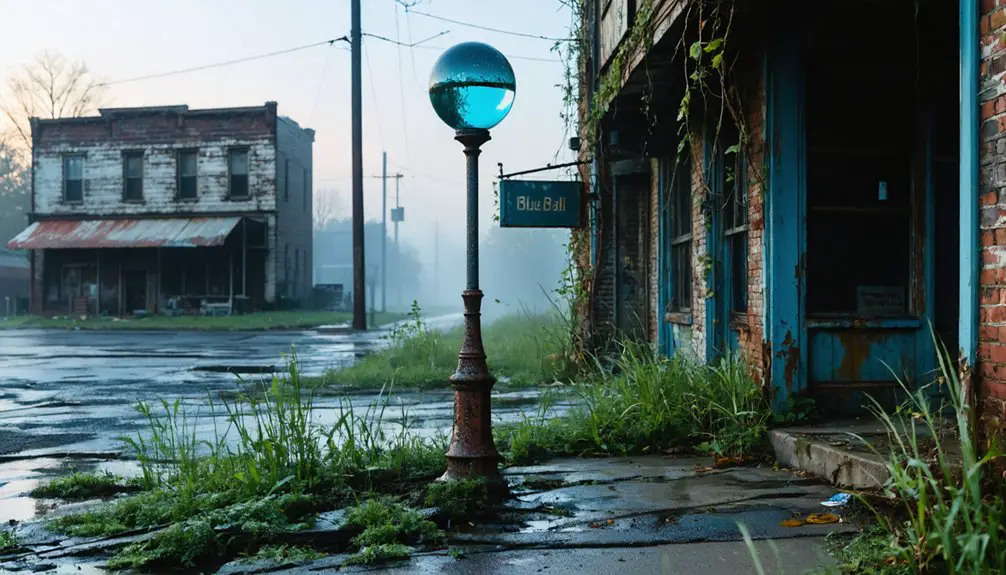
The blue metal ball that defined Blue Ball, Ohio‘s identity began as a practical solution in 1823, when tavern owner Jonathan Emmons erected the distinctive sign at his crossroads establishment.
This symbol evolution transformed a simple tavern marker into a powerful emblem of community identity that you can still see today.
The blue ball’s significance through time is marked by four key developments:
- Served as a crucial navigation aid for illiterate travelers along stagecoach routes
- Unified the area’s identity as it changed from Guilford to Blue Ball in the 1850s
- Became a prominent landmark along the important Dixie Highway
- Survived as a cultural touchstone even after Middletown’s 1993 annexation
Today, you’ll find the iconic blue ball still hanging at Roosevelt Road and Dixie Highway, preserving the ghost town’s legacy.
Middletown Annexation and Changes
When Middletown annexed Blue Ball in 1994, this historic crossroads community transformed from an independent settlement into a neighborhood within the expanding city. The annexation brought significant changes to Blue Ball governance, shifting jurisdiction from a split between Butler and Warren Counties to Middletown’s municipal authority.
You’ll find the area underwent substantial infrastructure upgrades, including modern traffic signals and improved roads near the historic Dixie Highway intersection.
The changes also affected Blue Ball demographics as residents gained access to Middletown’s municipal services and commercial developments like Towne Mall.
While the administrative structure changed, you can still see how the community preserved its historical identity, maintaining iconic landmarks like the blue ball sign while benefiting from urban modernization and expanded economic opportunities.
Preserving Blue Ball’s Legacy Today
Modern preservation efforts shape Blue Ball’s legacy through several key initiatives that honor its rich past while embracing contemporary community needs.
You’ll find heritage preservation thriving through:
- The iconic blue metal ball at Roosevelt Road and Dixie Highway, standing proudly as a symbol of the town’s identity.
- Blue Ball Presbyterian Church’s continued role as a cultural cornerstone for the community’s 752 residents.
- Local leadership’s commitment to maintaining historical structures and gathering oral histories from long-time residents.
- Community engagement through annual commemorative events and educational outreach programs at local libraries.
These preservation efforts guarantee Blue Ball’s story lives on, even after its 1993 annexation by Middletown.
The town’s architectural heritage, combined with active documentation and archival work, keeps its distinctive character alive for future generations.
Frequently Asked Questions
What Was the Average Property Value in Blue Ball During Its Peak?
In a million years of searching, you won’t find exact property values recorded. Based on regional property trends and historical economy, you’re looking at modest small-town Ohio values during early-mid 1900s.
How Many Stagecoach Routes Passed Through Blue Ball in the 1800S?
You’ll find that stagecoach history records aren’t definitive, but the crossroads location suggests at least 2-3 major routes passed through, connecting Cincinnati-Dayton and east-west traffic in the 1800s.
Were There Any Notable Crimes or Incidents at the Blue Ball Tavern?
You’ll find tavern history tells of innkeeper Prissy’s three vanished husbands and mysterious guest disappearances, though crime reports remain unverified. Stories of night-time digging and a wealthy woman’s suspicious death persist.
Did Native American Tribes Have Settlements in the Blue Ball Area?
While you’ll find evidence of Native settlements throughout Ohio, there’s no direct proof of permanent tribal history in Blue Ball’s immediate area, though Erie and Shawnee peoples frequented the region.
What Businesses Besides the Tavern Operated in Blue Ball’s Commercial District?
Like spokes around a wheel, you’d find a bustling general store, busy blacksmith shops, boarding houses, and skilled craftsmen’s workshops serving both locals and travelers along the main turnpike routes.
References
- https://www.midpointelibraryblog.org/blog/2021/3/25/tbt-blue-ball-ohio
- https://www.ghosttowns.com/states/oh/blueball.htm
- https://en.wikipedia.org/wiki/Blue_Ball
- https://theohioproject.net/category/places/ghost-towns-and-lost-places/
- https://wheninyourstate.com/ohio/11-ohio-towns-with-names-so-weird-youll-think-were-making-them-up/
- https://warren.ohgenweb.org/Bogan/bogan348.html
- https://listverse.com/2020/10/14/top-10-bizarre-us-town-names/
- https://discover.hubpages.com/travel/ohio-ghost-towns
- https://sites.rootsweb.com/~ohmhs/ecodev_ch02.htm
- https://dp.la/item/b46388de90f57954bee22d7da1ec4ae8
